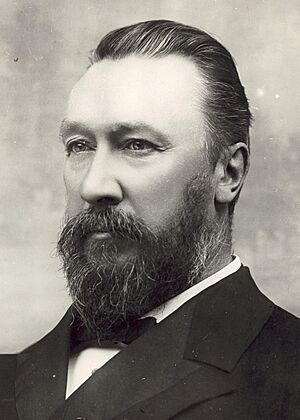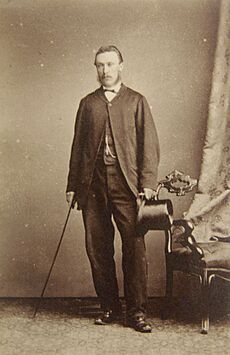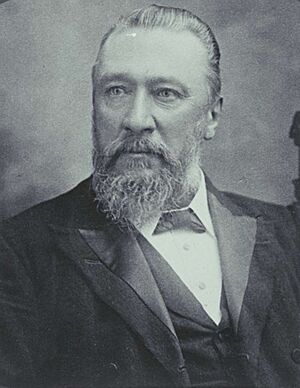William Lyne facts for kids
Quick facts for kids
The Honourable Sir
William Lyne
|
|
|---|---|
 |
|
| Treasurer of Australia | |
| In office 30 July 1907 – 12 November 1908 |
|
| Prime Minister | Alfred Deakin |
| Preceded by | John Forrest |
| Succeeded by | Andrew Fisher |
| Minister for Trade and Customs | |
| In office 5 July 1905 – 30 July 1907 |
|
| Prime Minister | Alfred Deakin |
| Preceded by | Allan McLean |
| Succeeded by | Austin Chapman |
| In office 11 August 1903 – 27 April 1904 |
|
| Prime Minister | Edmund Barton Alfred Deakin |
| Preceded by | Charles Kingston |
| Succeeded by | Andrew Fisher |
| Minister for Home Affairs | |
| In office 1 January 1901 – 11 August 1903 |
|
| Prime Minister | Edmund Barton |
| Preceded by | New office |
| Succeeded by | John Forrest |
| Premier of New South Wales | |
| In office 14 September 1899 – 27 March 1901 |
|
| Governor | Lord Beauchamp |
| Preceded by | George Reid |
| Succeeded by | John See |
| Member of the Australian Parliament for Hume |
|
| In office 29 March 1901 – 13 May 1913 |
|
| Preceded by | New division |
| Succeeded by | Robert Patten |
| Member of the New South Wales Parliament for Hume |
|
| In office 29 November 1880 – 20 March 1901 |
|
| Preceded by | George Day |
| Succeeded by | Gordon McLaurin |
| Personal details | |
| Born | 6 April 1844 Great Swanport, Van Diemen's Land, Australia |
| Died | 3 August 1913 (aged 69) Double Bay, New South Wales, Australia |
| Political party | Protectionist (before 1909) Independent (after 1909) |
| Spouses |
Martha Shaw
(m. 1870–1903)Sarah Olden
(m. 1905) |
| Relations | Carmichael Lyne (brother) |
Sir William John Lyne (born April 6, 1844 – died August 3, 1913) was an important Australian politician. He was the Premier of New South Wales from 1899 to 1901. Later, he became a minister in the first Australian federal governments. He is well-known for an event called the "Hopetoun Blunder." This is when he was unexpectedly asked to be the first Prime Minister of Australia, but he couldn't form a government.
Lyne was born in Van Diemen's Land (now Tasmania). He grew up on a farm. When he was 20, he tried farming sheep in North West Queensland, but he moved back to Tasmania after a few years. He then worked for the local government. In 1875, Lyne moved to New South Wales. He bought a farm near Albury and became active in his community.
He was elected to the New South Wales Parliament in 1880. He joined the government cabinet for the first time in 1885. Lyne was a member of the Protectionist Party. This party believed in protecting local industries by charging taxes on goods from other countries. He was a strong opponent of politicians who wanted "free trade," which meant fewer taxes on imported goods.
Lyne became the leader of the Protectionist Party in 1895. This made him the Leader of the Opposition in New South Wales. He stepped down for a short time but became leader again in 1899. He then became Premier, leading a government with the Labor Party. As Premier, Lyne's government made many important social changes.
In 1900, Lord Hopetoun, who was about to become the first Governor-General of Australia, asked Lyne to lead Australia's first national government. Lord Hopetoun thought that the leader of the biggest colony should be the first Prime Minister. However, Lyne had not supported the idea of Australia becoming a federation. Because of this, other important politicians, like Alfred Deakin, refused to work with him. Lyne could not form a government, so he had to give up the chance to be Prime Minister. This event became known as the "Hopetoun Blunder."
Instead, Edmund Barton, who had strongly supported federation, became the first Prime Minister. Lyne then became the Minister for Home Affairs in Barton's government. Later, he was the Minister for Trade and Customs and then the Treasurer under Prime Minister Alfred Deakin. In 1909, Lyne did not agree with the creation of the new Commonwealth Liberal Party. He spent the rest of his time in politics as an crossbencher, supporting the Labor government. He lost his seat in the 1913 election and passed away a few months later.
Contents
Early Life and Moving to the Mainland
William Lyne was born on April 6, 1844, in Great Swanport, Van Diemen's Land. This area is now known as Swansea, Tasmania. His father, John Lyne, was a farmer who also served in the Tasmanian Parliament. William went to school at Horton College in Ross, and later had a private teacher.
When he was 20, in the mid-1860s, Lyne left Tasmania. He traveled to northern Queensland with his cousin, Henry Steiglitz, to start a farm. They camped near the Gregory River. However, Lyne found that the climate in Queensland did not suit him. He returned to Tasmania after about a year.
Back in Tasmania, he worked as a clerk for the Glamorgan Council. After ten years, in 1875, Lyne moved to the mainland again. He bought land at Cumberoona, near Albury, in New South Wales.
Becoming a Politician in New South Wales
Lyne became a member of the New South Wales Legislative Assembly in 1880, representing the area of Hume. He was a member of the Protectionist Party. This party believed in "protectionism," which meant putting taxes on goods imported from other countries. This was done to make local products cheaper and help Australian businesses grow.
He held several important roles in the New South Wales government. In 1885, and again from 1886 to 1887, he was the Secretary for Public Works. This job involved overseeing big building projects. In 1889, he became the Secretary for Lands. From 1891 to 1894, he was again the Secretary for Public Works.
Lyne was a strong supporter of expanding the railway system. He pushed for the building of the Culcairn to Corowa railway line in his own area.
In 1895, George Reid became Premier, representing the "free trade" side. Lyne then became the Leader of the Opposition. In 1898, he stepped aside as leader for a short time. However, in August 1899, he became the leader of the Protectionists again.
Lyne quickly became Premier because of a problem with the previous government. He worked with the Labor Party to form a government. As Premier, Lyne's government passed many new laws between July and December 1900. These included laws about:
- Early closing times for shops.
- Rules for coal mines and help for miners who had accidents.
- Pensions for older people.
- Graduated death duties (taxes on inherited money that increased with the amount).
These changes showed that Lyne's government was focused on social reforms and helping ordinary people.
Australia Becomes a Nation: Federation
During the 1890s, there was a big debate about whether the Australian colonies should join together to form one country, called a "federation." Lyne actually preferred "unification," where the colonies would become one single government, rather than a federation where they kept some of their own powers.
He was one of the representatives from New South Wales at the 1897-98 convention where the Australian Constitution was written. However, he missed many of the meetings. Lyne publicly said "No" to the proposed constitution in the 1898 referendum. He was still unhappy with the updated plan in the second referendum in 1899.
Even though George Reid, the Premier at the time, strongly supported federation, Lyne continued to protest. However, the "Yes" vote won by a large amount in the second referendum. Lyne soon accepted that Australia would become a federation.
Lyne's Role in Federal Politics
When the Australian colonies joined together to form a nation in January 1901, Lyne believed he should be the first Prime Minister of Australia. This was because he was the Premier of New South Wales, the largest colony. This idea was based on what happened in Canada, where the leader of the biggest colony became the first Prime Minister.
The first Governor-General, Lord Hopetoun, agreed and offered the job to Lyne in December 1900. Lyne was asked to lead a temporary government until the first federal election. However, Lyne had been against federation. Because of this, most other important politicians, like Alfred Deakin, told Lord Hopetoun they would not work under Lyne.
When it became clear that Lyne could not form a government, he gave up the offer. Lord Hopetoun then had to agree with the majority of politicians. They believed that Edmund Barton, who had led the movement for federation, should be the first Prime Minister. Lyne's failure to form a government is known as the "Hopetoun Blunder."
On January 1, 1901, Lyne became the Minister for Home Affairs in Edmund Barton's first government. In March 1901, he was elected to the first federal Parliament as the member for the Division of Hume. As Minister for Home Affairs, he was in charge of important new laws. These included the Commonwealth Franchise Act 1902, which gave women the right to vote in federal elections. He also helped set up the Commonwealth Public Service.
Lyne remained Minister for Home Affairs until August 1903. Then, he became the Minister for Trade and Customs. He kept this job when Alfred Deakin became Prime Minister in September. After the election in December 1903, no single party had a clear majority. Deakin had to resign in April 1904 but returned as Prime Minister in July 1905, with Lyne back in his old role.
In April 1907, Lyne traveled with Deakin to a meeting of colonial leaders in Britain. Lyne tried to convince British politicians that their policy of "free trade" was not good for the colonies. Deakin and Lyne returned to Australia in June. When Sir John Forrest resigned as Treasurer in July 1907, Lyne took over the position.
Lyne is also remembered for the 'Lyne Tariff' in 1908. This was a law that greatly increased the taxes on imported goods. This was a big win for politicians who supported "protectionism" and helped local industries. It marked the end of the main political disagreement in Australia before federation, which was between protectionism and free trade.
Later Political Career
In November 1908, the Labor Party stopped supporting Deakin's government. Andrew Fisher became Prime Minister. In June 1909, Deakin and Cook joined forces to form the "Fusion" government, also known as the Commonwealth Liberal Party. Lyne strongly disagreed with Deakin's decision to join this new party. He felt betrayed and became an independent politician, still supporting protectionism.
Lyne often criticized Deakin during the 11 months the Fusion government lasted, but Deakin did not respond. In the April 1910 election, the Labor Party won by a large amount. Lyne was elected as an independent politician who supported Labor. However, he lost his seat in the May 1913 election when the Labor Party lost to the Commonwealth Liberal Party.
Personal Life
After his first wife, Martha Shaw, passed away, Lyne married Sarah Jane Olden in 1911.
Sir William Lyne died in Double Bay, a suburb of Sydney, in 1913. He was survived by one son and three daughters from his first marriage, and by his second wife and her daughter. In 1960, Lady Sarah Lyne gave a picture of the opening of the first Federal Parliament to Lyneham High School, which had just opened. Lady Lyne passed away in Canberra in 1961 and is buried in Woden Cemetery.
Honours and Legacy
William Lyne was made a Knight Commander of the Order of St Michael and St George (KCMG) in 1900. This is a special honour given by the British Crown.
Two places in Australia are named after him:
- The federal electoral Division of Lyne, which is an area that elects a member to the Australian Parliament.
- The Canberra suburb of Lyneham.
Images for kids
See also
- Australian Commonwealth ministries 1901-2004




